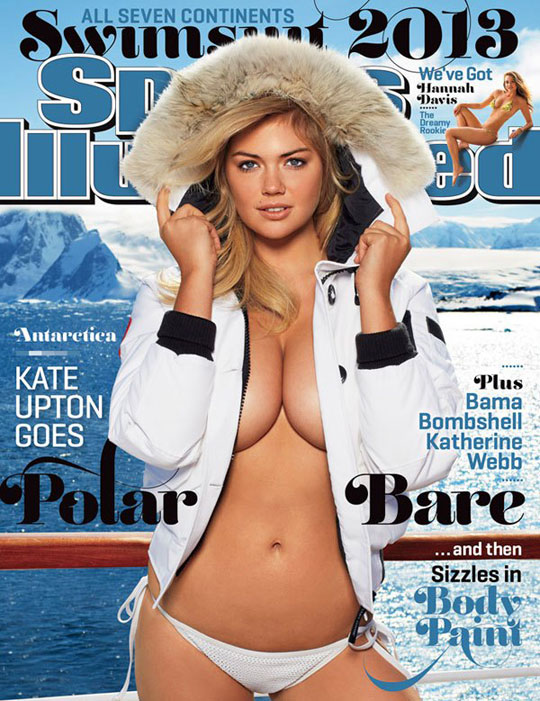
Psychoanalysis, Discourse Analysis, Audience Studies of Sports Illustrated Swimsuit Issue Covers

Psychoanalysis, Discourse Analysis, Audience Studies of Sports Illustrated Swimsuit Issue Covers
The magazine, Sports Illustrated, publishes the Sports Illustrated swimsuit issue annually.The cover photograph of Sports Illustrated swimsuit issue features fashion models wearing swimwear in exotic locations. The Sports Illustrated swimsuit issue has grown from being just an issue of the magazine to full space at a time of year with little sports news into a major marketing franchise that now includes a special separate issue. The magazine has become a fashion issue for beachwear worn by the world's top models.
The Sports Illustrated swimsuit issue is successful for a number of various reasons. First, the magazine is covered by gorgeous models that with just a glimpse of them on the cover could catch any viewer's eye, man or woman. They are presented to us in swimwear, which is usually a very sexy and seductive bikini. Another reason for the success of Sports Illustrated swimsuit issue is that it only features supermodels in swimwear but does not feature women athletes as they are thought to be too masculine for the cover photograph. More often than not, "the swimsuit issue featuring models and not athletes shows women sunbathing in the briefest of bikinis on tropical beaches (Wenner 182)." The magazine does an amazing job at representing the supermodels to look attractive and catch every eye when they walk by the magazine stand. "When sexually objectified in this way, women are symbolically subordinated to the erotic desires of men (Wenner 182)."
There are numerous ways to closely examine and analyze the covers of Sports Illustrated swimsuit issue. After entering the website you will see a psychoanalytic analysis, discourse analysis, and audience study, as well as how the magazine interpellates the readers and viewers. Psychoanalysis, developed and revised by Sigmund Freud, consists of a range of theories that deal most centrally with human subjectivity, sexuality, and the unconscious (Rose 149). Psychoanalysis will venture on into what Freud calls scopophilia, male gaze, phallocentrism, as well as subjectivity, and the unconscious which we will discuss later along with a deeper concept of psychoanalysis of Sports Illustrated swimsuit issue. A discourse study refers to groups of statements that structure the way a thing is thought, and the way awe act on the basis of that thinking. In other words, discourse is a particular knowledge about the world which shapes how the world is understood and how things are done in it (Rose 190). A discourse analysis will study the relationship of power about the magazine as well as surveillance. The audience study, or audiencing, refers to the process by which a visual image has its meanings renegotiates, or even rejected, by particular audiences watching in specific circumstances (Rose 30). Audiencing deals with how the magazine is seen and decoded, as well as the hegemony that the magazine produces. Interpellation, also known as appellation, is referred to when an advertisement pulls the spectator into their signifying effects (Rose 134). So after the magazine draws the reader in or interpellates the reader, then a psychoanalysis, discourse analysis, and audience study can be conducted.
Examining and analyzing Sports Illustrated swimsuit issue is helpful to our culture and society in many ways. It allows for the research to be done on what is seen as the cultural norm for women regarding their bodies, the desire that men and women both have, pleasure that our society attains through looking or staring, as well as power, and subjectivity. "In Sports Illustrated's annual swimsuit issue, they display their athletic prowess-the astonishing ability to lounge, wet from saltwater or sweat, in impossibly skimpy swimsuits (Walsh-Childers 141)." This allows for the swimsuit issue to be a vital piece for several types of analysis. There is a relationship with the magazine and the viewers and what is seen on the covers of those magazines, therefore showing what is attainable or unattainable for men and women in our society. "Objectification, commodification, and voyeurism were identified as formal media structures that contribute to sexism and stereotyping in the media, and she showed how each of these mechanisms occurs in the Sports Illustrated swimsuit issue (Wenner 39)."
 |
| Psychoanalysis |
Walsh-Childers, Kim. "Women As Sex Partners." Images That Injure: Pictorial Stereotypes in the Media. Westport, CT: Praeger, 1996. N. pag. Print.
Wenner, Lawrence A. Mediasport. London: Routledge, 1998. Print.
http://sportsillustrated.cnn.com/swimsuit/
May 8, 2013